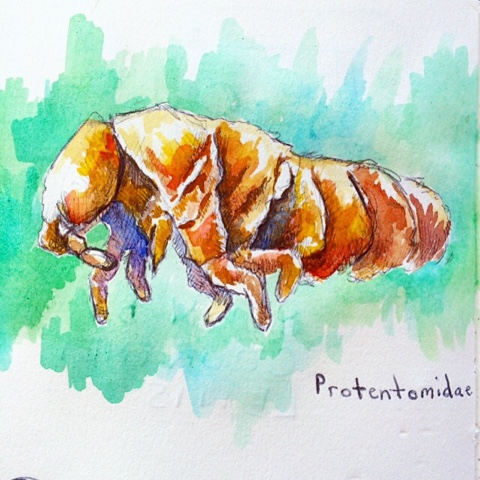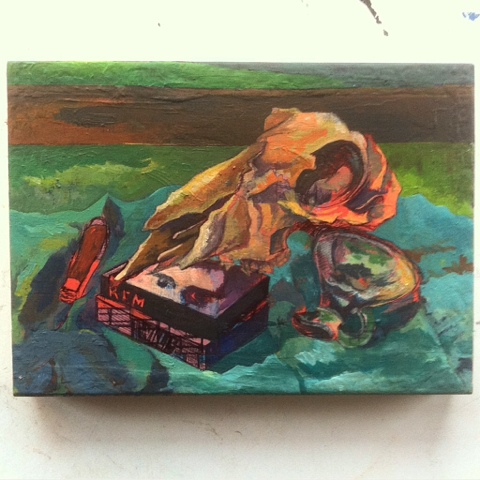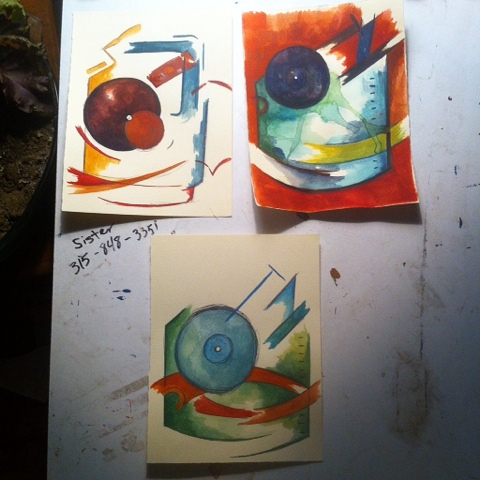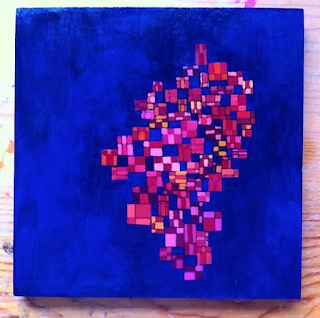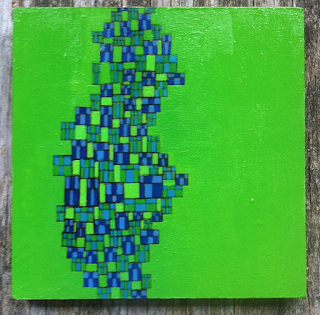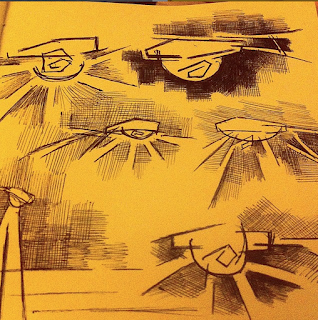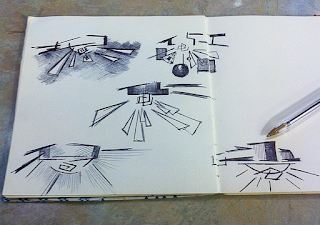Over the past several years I have watched many artists working on a drawing or painting a day sort of projects. They always seem so fascinating. The very idea of maintaining an idea or theme throughout the entirety of a year seems downright daunting to me, but here I am on day sixteen of doing a watercolor of an insect every day of 2016.
Author: mightylark
I’ve had the Vestibule Gallery lined up for a couple months now. The space is prime; located right on Congress Street in downtown Portland, ME. I haven’t even had a solo show in Portland since 2005 and that was in a coffee shop. Needless to say I’ve been trying to put something good together, to the point where I’d have to say I was overthinking it.
It seemed like a natural act. I pulled my travel paints out on my parents kitchen table one by one. Austin and Courtney lay asleep in my old bedroom. We had gotten to my folks house at about 8:30 Thanksgiving night. It was the first Courtney was able to come with me. I felt so grateful for her, the time she spends sewing for our family, the way that she carries my anxieties just as I carry hers. She had left a spool of Guterman thread out on the table and as I looked at it and the way that the lines and shapes crossed and crossed and the feeling of the shadow on that object it felt like it was indicative of everything.
Creating art with an audience seems at once both daunting and inspiring. Even the most casual visitor to the studio often breaks my concentration for hours. At the same time, I have long wanted to create a mural or some other piece of public art. I enjoy the idea of artwork that is immediately accessible to a broad audience and not simply limited to gallery visitors and the sadly endangered creatures we know as “art collectors.” I have had some limited experience with viewing my work in a public environment. In 2011, I participated in the Billboard Art Project in New Orleans. It was incredible seeing my work at that scale with the actual earth and sky as the backdrops to my representative imagery. That experience left me wanting for a more permanent experience, however. While I was able to see my artwork on a grand scale, I did not experience the process of painting in the midst of the public; creating under observation.
It was with great pleasure, then, to be approached my Meg Shorette, of Launchpad and Central Gallery, to participate in the Queen City Piano Project. Meg and her crew of volunteers placed 5 pianos in parks throughout Bangor, ME. Each piano was to be hand-painted and designed by a different artist. I immediately could see my random and spontaneous patterns working their way across the body of a piano. It seemed to me the best opportunity I had had thus far to paint on a piece of found material and to create in the public. Coupled with this excitement was also the fear of becoming some sort of natural history exhibit or feeling like an animal penned up on display in the zoo. I imagined greetings from the public a la Steve Irwin. “Well, look ‘ere, mate. I’s an a’tist in ‘is natu’al habitat. Let’s poke him, eh?”
I have always envisioned my favorite artists, like McGee and Jasper Johns to be impervious to an audience, capable of focusing on their artwork at all times, while conversing with visitors or not. Jackson Pollack seemed dependent on an audience while painting, to validate his creative act, his performance. Alternatively, I was reading a blog post by Janice Mason Steeves in which she claims that she needs a space to herself in order to create work of consequence and quotes one of my favorites, Franz Kafka, who apparently couldn’t bear an audience.
“You once said that you would like to sit beside me while I write. Listen, in that case I could not write at all. for writing means revealing oneself to excess; that utmost of self-revelation and surrender, in which a human being, when involved with others, would feel he was losing himself, and from which, therefore, he will always shrink as long as he is in his right mind…That is why one can never be alone enough when one writes, why there can never be enough silence around one when one writes, why even night is not night enough.”
In a blogpost on painting a hallway, writer, Paul Kleiman, talks about Stanislavski’s “Circle of Concentration,” the idea to choose your area of focus. He suggests that when you are painting you are able to reduce your area of focus to the spot right in front of you on your painting, noticing its irregularities and the movements of your brush only.
In truth, my studio practice is very much like this. It is all about solitude and the zen sensibility that a paint brush, palette and surface will elicit. It is about rhythm an motion and being in tune with the surface. I felt that this was a very private endeavor, but when I made it to Pierce Park to paint my piano, I found myself able to shrink my focus, to still create like I was in private. For all intents and purposes, I was by myself. I was unaware of the world around me but for the surface in front of me, but only using the idea of the “circle of concentration.”
I dove into my piano without a clear image of what I wanted it to look like in the end. I stuck with the locked box set of rules that I have been using in many of my patterns recently. The shapes of included in the patterns are all rectangles and vary only slightly within my locked box vernacular. The patterns grow spontaneously; one shape at a time in relation to the previous shapes. I was thinking about Thelonious Monk and Ahmad Jamal while drawing and painting this project, trying to solo using the limited locked box rules as jazz scales. The result seemed to be the most mature realization of the pattern making that I have experienced thus far.
I had relatively few visitors while finishing up the piano, but the people who did visit were interesting to talk with and seemed pleased to have a piece of public art available in the small city of Bangor. Due to my thoughts of jazz soloing, the experience seemed performative even when there was no one there. Ultimately, I found it compelling to create in an arena where people could see me working, enjoy the progress of the work, and take ownership of the process. I hope to create more work in the public sphere in the future. It felt as though the work was co-authored by the community that I was working in and that the work had a purpose to a wider audience.
Peace
-mike
You always want to write yourself as a good character. We always want to be the good guy, someone people empathize with. I’ve been reading a book of Japanese fairy tales to my son the past couple days and it has me questioning the idea of good people. We assume that if we are good people that people will treat us the way we should be treated, we will be addressed equivocally, our deeds will be remembered with satisfaction, but, as in these Japanese fairy tales, however, what if this just isn’t true? What if it’s a misconception that people who are by and large good people are actually not doing enough, or what if without the awareness of their acts both good and bad they are not completely whole?
I struggle with this idea and many other smaller thoughts that may be my undoing, causing a lack in motivation, or may be conversely, my strength, providing my work, love, and character with that necessary depth to be whole. Still, I struggle with empathy. I get lost in the trappings of my work, the idea that I must keep working, solving my own life’s mysteries, creating because creating is what brings me energy and peace. I made a promise to myself that I would work hard enough to get to that elusive somewhere with my art. I set the sights at where certain artists, like Jeff Soto and Barry McGee were showing and creating, determining that I needed to get there in order to be successful. For about a dozen years I’ve labored at this. I’ve created a formidable body of work, but no piece of which has brought me the stardom or notoriety that either of these heroes have attained.
Along the way I’ve married and had a beautiful son. I’ve stopped cooking in restaurants and am now an adjunct faculty member, teaching art to people in their late teens and early twenties. I have a comfortable studio and a comfortable home. I can create comfortably every day of the week.
It doesn’t always make me happy though. I long for so many things I can’t have. I long for places where I’ve felt that I was more creative. I long for better galleries, better artist friends, more stimulating conversation and a deeper and more whole understanding of what it is that I do. If I could just have a deeper understanding of what it is that I am doing, maybe I could focus, feel good about the course that I am on, be validated, both in the creative work that I do and the qualities that I have to offer at my workplace. But the truth of the matter is that beyond receiving a raise, or a newer
shinier teaching position with a tenure track and benefits, there is little validation that I can receive that will affect my life and the life of my family.
Recently, I’ve felt like maybe I’ve been the bad guy in my own story. I’ve felt short with my family and with my work. I went through a month long period where I was searching for new opportunities, new jobs, gallery shows, creative outlets of any kind. I wanted to live life filled to the gills with my art again, but it never occurred to me until I was reading fairy tales to my child that maybe my cup was full and that’s why I’m having trouble pouring more into it.
I’ve created so much in the past two months and I am truly overwhelmed by the experience. My work has grown, but I’m now at that stage where I need to let the soul grow into that space that the work has created. Yesterday, I cleaned my studio again. I consider it the rebirth, just in time for the winter, a season of rumination and creation. Winter always provides me with that opportunity to go slow and reflect. I hope it’s long and cold, because I will be inside filled with the warmth of my family’s love, the joy of my studies, and the satisfaction of my work.
Today was the first day of class for one of my sections of 2d design. Generally my 2d design class is filled with a number of non-art people. This is the nature of a community college, and I will say that most of the time, it is the complete privilege of teaching at a community college. I hae met some incredible people who are multifariously gifted and individual.
Here are a few suprematist coffee pots that I have been working on. I’m interested in the order of shapes necessary to communicate the object. I’ll keep you posted.
The Diamond is Inside
I watched The Beautiful Losers with my wife tonight. It was her first time. And though the artists in that movie/book/show are much more successful, at least in monetary terms, than I am, I felt like it was an insight into my thought process; where my head and heart are at when they seem checked out.
I read a piece today on Ornette Coleman, by Miles Bullough, while settling into studio. I was fascinated to read that bop king Dizzie Gillespie didn’t even think of Coleman’s playing as jazz. The article went on to explain that Coleman didn’t receive any formal education and didn’t follow any of the previously accepted modal and measured solos. Rather he played what felt right and sounded right to him in a spontaneous moment. The head, or lead in the number would play, and then the sounds would be off to run the gamut. I slipped The Shape of Jazz to Come on today after reading the article. There was something in that album that felt so in tune with what I am doing in the “Gridlock” Series. It is a spontaneity, an improvisation, but not one that has definitive rules. It is more of a puzzle, finding the right piece to fit in response to the previous shape, with some basic intent at a cohesive whole, but nothing explicit.
Coleman’s wandering bars seemed like just the fit to my shapes and as I added color to finish up my pieces, I started listening to Charles Mingus, Live at Antibes, one of my favorite albums. “Folk Forms” is one of my favorite jazz pieces. It aspires to this same sort of mindset, I think. Fitting the current piece with the previous piece. Don’t obsess too much about the whole, because the decisions that you make are innate. Let the artwork or music be.
It is important for me to allow this side of my brain to be. When I over think work or focus too definitively on the details of the work, it never seems to happen. I create a dud. Only when I allow my intuition to take over to I find the peace of mind to make a successful work. The successful work is a conversation, not in words translated to paint, but in paint to paint.
Peace
-Mike
When I am busy with my daily life, I often have trouble maintaining my creative focus. When I am allotted time to work in studio or at home I will often feel bitter that I must work right then, that I don’t get a day to just be off from work, free to do what I want. I begin to constrain my creative ideas by overanalyzing daily situations, absorbing outside pressures, and ultimately trying too hard to make as much of my time as possible. When entrenched in one of these ruts it is difficult to remember that I am most successful when I allow my mind to wander.
The other night I was sitting in my easy chair looking out the window. I began to draw a street light in a sketchbook and three days later have done over ten drawings of these street lights. Mind you, were I not working full time over the summer, I would probably have more of these drawings done, but that’s okay. The idea is down. I will be more prolific in the fall when I start teaching again. For now the idea is down, I have something to noodle with, and I am not gritting my teeth trying to work too much out of myself.




